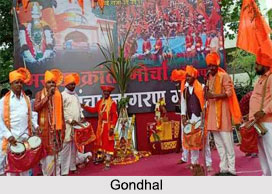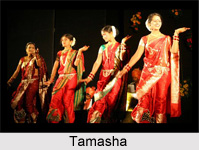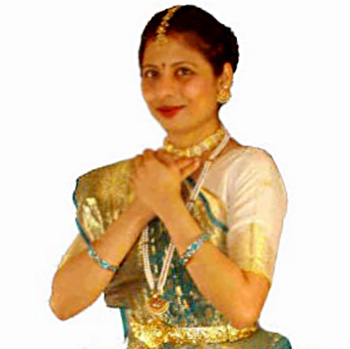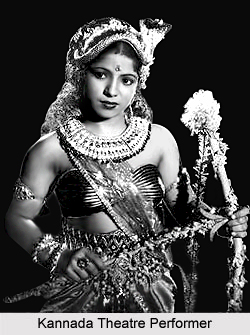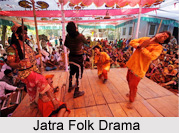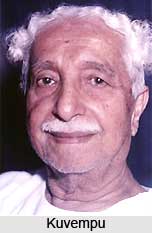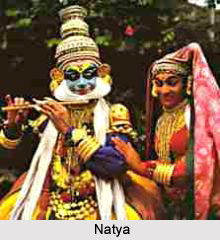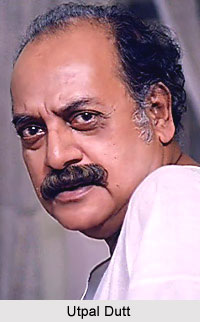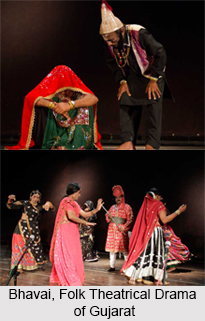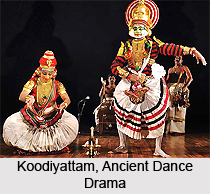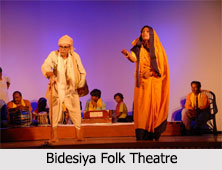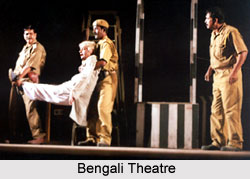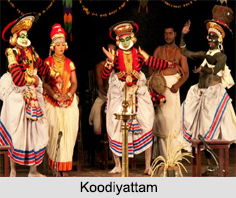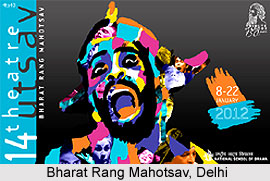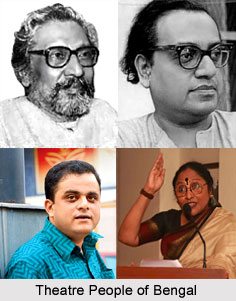Introduction
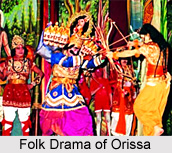 Folk drama of Orissa consists of number different types of theatrical performances. These are mainly meant to regale rural audiences with their various entertaining as well as religious themes. The various types of folk drama of Orissa include Suanga, Leela, Mughal Tamasha, Jatra, Danda Nata, Sakhi Nata, Dhanu Yatra and more. Some of the prominent folk drama types are discussed below.
Folk drama of Orissa consists of number different types of theatrical performances. These are mainly meant to regale rural audiences with their various entertaining as well as religious themes. The various types of folk drama of Orissa include Suanga, Leela, Mughal Tamasha, Jatra, Danda Nata, Sakhi Nata, Dhanu Yatra and more. Some of the prominent folk drama types are discussed below.
Jatra
The present Jatra in its opera form came to Orissa from Bengal in the last quarter of the 19th century. The pioneers in the field of Jatra in Orissa were Baishnab Pani, Gopal Das, Jagannath Pani and Balakrishna Mohanty.
Suanga
Suanga started as independent play but afterwards it turned out to be light-hearted interludes between two scenes in a Jatra. Now it stands for farcical acting. It is a form of Geetabhinaya in which all the characters sing the dialogue. There are two types of Suangas found in ancient Oriya literature. The `Deulatola Suanga` by Bipra Nilambar is about the construction of the famous Jagannath temple. Another Suanga, `Laxmipurna Suanga` by Balaram Das narrates the quarrel between Goddess Laxmi on one hand and Lord Jagannath and his elder brother Balabhadra on the other. In the beginning of a Suanga, Nata and Nati appear to introduce the play.
Mughal Tamasha
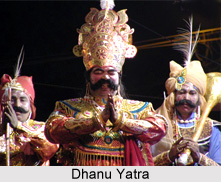 The Tamasha mainly intends to entertain audiences. Late Bansiballav Goswami had written the Mughal Tamasha in 1728 A.D. The Mughal Tamasha is divided into two parts, i.e., `Badasahi` and `Soudagari` Tamasha. Nowadays only the Badasahi Mughal Tamasha script is available and being staged. It is a folk play. The dialogue is in a hybrid language of Oriya mixed with Urdu language and Persian. Violin, Pakhavaj, Jodinagara and Kubji were the main instruments used in the Tamasha. The Tamasha begins with a prayer to God or Goddess and is followed by group dance. There is innocent parody of Muslim rulers in these plays. These plays went a long way to establish communal harmony.
The Tamasha mainly intends to entertain audiences. Late Bansiballav Goswami had written the Mughal Tamasha in 1728 A.D. The Mughal Tamasha is divided into two parts, i.e., `Badasahi` and `Soudagari` Tamasha. Nowadays only the Badasahi Mughal Tamasha script is available and being staged. It is a folk play. The dialogue is in a hybrid language of Oriya mixed with Urdu language and Persian. Violin, Pakhavaj, Jodinagara and Kubji were the main instruments used in the Tamasha. The Tamasha begins with a prayer to God or Goddess and is followed by group dance. There is innocent parody of Muslim rulers in these plays. These plays went a long way to establish communal harmony.
Dhanu Yatra
In Pusha Purnima, Dhanu Yatra is observed in Bargarh near Sambalpur district for eleven days. Dhanu Yatra is the theatrical presentation of Krishna Leela. It is a moving or mobile theatre. It starts from Ambapali and slowly moves towards Bargarh town while enacting appropriate scenes on the way. One who plays the role of Kansa is treated as a real ruler of Bargarh city for those eleven days.
Chadheya Nata
Chadheya Nata is a folk play prevalent in districts of Mayurbhanj and Balasore. In this play, there are mainly three characters, namely, the Chadheya, the Chadheyani (wife of Chadheya) and Banku Bhai, the joker. It is a musical form, the songs of the characters being repeated by a choral group with musical instruments. The chief of the play is called Mausa who controls the performance and interprets the whole play.
Leela
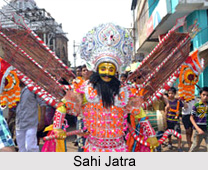 In this form of opera a chorus group narrates the everyday acts of God in his incarnation as Lord Krishna or Lord Rama. Various episodes from Lord`s life especially Rama`s heroic acts and Krishna`s frolicking with the Gopis and Radha are played in Ramlila and Raslila respectively. Jagannath Das was the first pioneer of the Leela tradition.
In this form of opera a chorus group narrates the everyday acts of God in his incarnation as Lord Krishna or Lord Rama. Various episodes from Lord`s life especially Rama`s heroic acts and Krishna`s frolicking with the Gopis and Radha are played in Ramlila and Raslila respectively. Jagannath Das was the first pioneer of the Leela tradition.
Sahi Jatra
Sahi Jatra is special form of folk theatre of Orissa. This Jatra is mainly performed in Puri district. The word `Sahi` means `alley` or street. Sahi Jatra refers to a street procession. During the first month of spring Sahi Jatra is performed continuously for three days. The characters like Kela-Keluni, Shabara-Shaburuni, etc. play their role behind huge unusual, hollow human figures. The figures are mobile and unusual with big head, long nose, huge tummy and long legs. In the front row of this procession, the musicians, drummers and singers march. The main character is the Naga. He represents a manifestation of Lord Jagannath.
Prahlad Natak
Prahalad Natak, literally meaning a play about Prahlad, belongs to Ganjam district in south Orissa. It is more or less in the form of Suanga. The play has twenty male characters and five female characters except the Gahaka - the main singer leader and Sutradhara of the play. There are a hundred and twenty songs in the play. Each is composed in a particular Raaga and Tala.
Folk Dances of Dhenkanal District
Folk dances of Dhenkanal District depict the traditional and cultural heritages of the local people. There are a number of folk dances of this district of Orissa that draw the attention from every corner of the country. The folk dances of this district contribute to the art and culture of the region.
The various popular folk dances are as follows -
Paika Akhada: Paika Akhada is the traditional folk dance form. This dance pattern is attributed to the Bali ant militia known as the Paikas. During ancient time the Paikas were the warriors who fought for their kingdom. The Samartarang of Barjanath badjana depicts the courage of this martial class. The descendents of those fighters are scattered in the rural areas of the Dhenkanal District. During the festival of Dussehra, near about 200 groups of Paikas congregate at Sura Pratap ground to exhibit this age old martial tradition.
Gopala Laudi: This dance pattern is popular among the gopalas of the district. A group of 12 to 16 persons dressed with attractive costumes performs this traditional dance. A set of wooden sticks is also required. The singer sings the songs of the cow herd boys. This depicts the dance and playfulness of Lord Krishna and his mates. This dance form is mainly performed during Dol purnima.
Danda Nacha: This is the most popular form of folk dance. Danda Nacha has a spiritual background. In the month of Baisakh the devotees observe a spiritual ritual and observe fasting. During the fasting they worship a stick known as Danda at the temple of their Goddess. Danda Nacha reflects different aspects of the life of the rural folk.
Gumura: Dhenkanal District has a special type of Ghumura dance. Generally, four to ten persons dance to the tune of `Gumura`- an ancient musical instrument made of a medium sized earthen pot covered with goat skin.
Changu: The Juangas perform the Changu dance. Changu is an instrument in which goat skin is covered over a wooden structure. The Juangs having a group of 10 to 15 men and women dance together while the musicians play the Changu. Changu dance is performed in several occasions like marriage, harvesting festivals and birthday and so on.
Odissi Kirtan: Unlike the Nadia Kirtan where the singers, musicians and the participants dance, the participants of Odissi Kirtan sit in a row and perform the Kirtan. They sing the `Odissi Bhajans` in pure Odissi style by following `raga` and `talas`. Odissi Kirtan is performed in the occasions like `Dol Purnima` `Gamha Purnima`, `Snana Purnima`, `Ratha Yatra` and many other socio religious functions.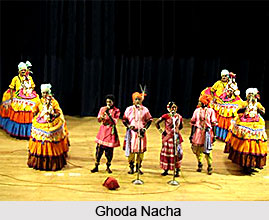
Dhuduki Nacha: `Dhuduki Nacha` is displayed by two or more persons. The players use an instrument known as `Dhuduki` which is made of a medium sized wooden drum cover with iguana skin and a wooden bar in the middle of the drum tied with metal string. The `Dhuduki` dancers dressed with attractive costumes sing and dance and at the intervals play their `Dhuduki`.
Kendera Gita: The Yogis or the Nathas sect play the Kendera while begging. Kendera is a small musical instrument like violin.
Kandhei Nacha: There are `Kandhei Nacha` groups or Puppet Theatres at Bhapur. This art form based on the preparation of puppets of different characters. The theatre group moves from one place to another. They prepare a temporary stage and perform some historical, social plays through the puppets. The puppets are controlled by threads connected with the fingers of the puppet artists behind the back drop.
Ghoda Nacha: `Ghoda Nacha is a popular folk dance in Dhenkanal. Generally the fishermen perform this dance. A male member of the team enters in a wooden structure of a horse and holds it around his waist looking as if riding the horse. He dances with a female partner with the music of trumpet and drum. Both the partner asks witty questions to each other in their songs. When the male asks the question the female replies and it continues vice-versa.
Mahila Palla: `Palla` is an age old performing art. Years ago only males used to perform this dance form. But with time females have started participating. The Mahila Palla is performed exclusively by the females. The Gayika, the Baika, the Palia and the Siri Palia all are females. The Mahila Palla groups are found at Kamakhyanagar, Jamuna Kot, Gondia and Sadar Block.
These dance forms of Dhenkanal District have kept the rich inherited tradition alive.
